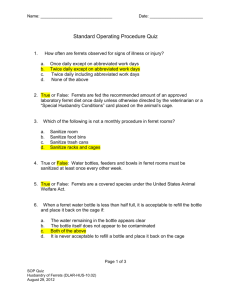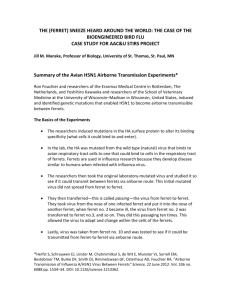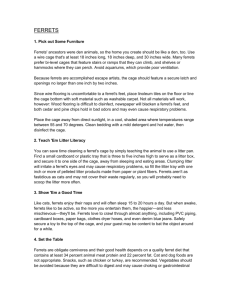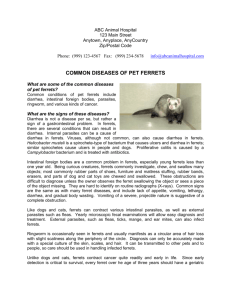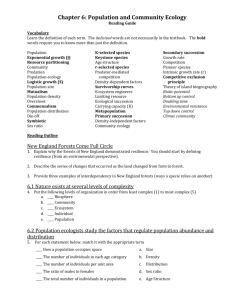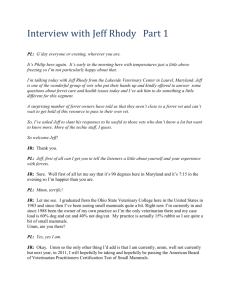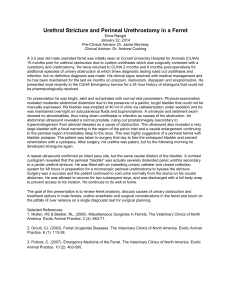CARING FOR YOUR FERRET
advertisement
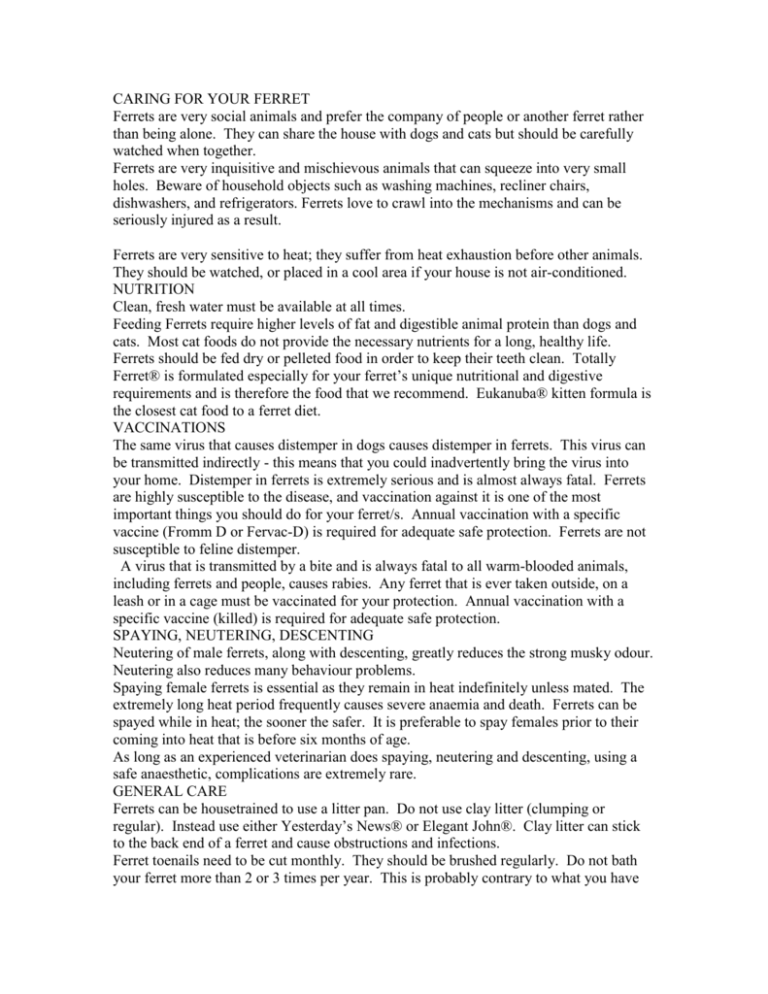
CARING FOR YOUR FERRET Ferrets are very social animals and prefer the company of people or another ferret rather than being alone. They can share the house with dogs and cats but should be carefully watched when together. Ferrets are very inquisitive and mischievous animals that can squeeze into very small holes. Beware of household objects such as washing machines, recliner chairs, dishwashers, and refrigerators. Ferrets love to crawl into the mechanisms and can be seriously injured as a result. Ferrets are very sensitive to heat; they suffer from heat exhaustion before other animals. They should be watched, or placed in a cool area if your house is not air-conditioned. NUTRITION Clean, fresh water must be available at all times. Feeding Ferrets require higher levels of fat and digestible animal protein than dogs and cats. Most cat foods do not provide the necessary nutrients for a long, healthy life. Ferrets should be fed dry or pelleted food in order to keep their teeth clean. Totally Ferret® is formulated especially for your ferret’s unique nutritional and digestive requirements and is therefore the food that we recommend. Eukanuba® kitten formula is the closest cat food to a ferret diet. VACCINATIONS The same virus that causes distemper in dogs causes distemper in ferrets. This virus can be transmitted indirectly - this means that you could inadvertently bring the virus into your home. Distemper in ferrets is extremely serious and is almost always fatal. Ferrets are highly susceptible to the disease, and vaccination against it is one of the most important things you should do for your ferret/s. Annual vaccination with a specific vaccine (Fromm D or Fervac-D) is required for adequate safe protection. Ferrets are not susceptible to feline distemper. A virus that is transmitted by a bite and is always fatal to all warm-blooded animals, including ferrets and people, causes rabies. Any ferret that is ever taken outside, on a leash or in a cage must be vaccinated for your protection. Annual vaccination with a specific vaccine (killed) is required for adequate safe protection. SPAYING, NEUTERING, DESCENTING Neutering of male ferrets, along with descenting, greatly reduces the strong musky odour. Neutering also reduces many behaviour problems. Spaying female ferrets is essential as they remain in heat indefinitely unless mated. The extremely long heat period frequently causes severe anaemia and death. Ferrets can be spayed while in heat; the sooner the safer. It is preferable to spay females prior to their coming into heat that is before six months of age. As long as an experienced veterinarian does spaying, neutering and descenting, using a safe anaesthetic, complications are extremely rare. GENERAL CARE Ferrets can be housetrained to use a litter pan. Do not use clay litter (clumping or regular). Instead use either Yesterday’s News® or Elegant John®. Clay litter can stick to the back end of a ferret and cause obstructions and infections. Ferret toenails need to be cut monthly. They should be brushed regularly. Do not bath your ferret more than 2 or 3 times per year. This is probably contrary to what you have been told in the past because “ferrets stink” if they are not bathed frequently. Actually the opposite is true! The more you bath, the stinkier the ferret becomes because the skin goes into overtime trying to replace the oils in the skin lost to bathing. Ferrets often develop hairballs, which cause constipation. This is a yearlong problem but is especially common when they are shedding in spring and autumn. To prevent problems, use the tasty feline hairball laxative weekly and every three days during the shedding seasons. Ferrets are very shortsighted and so have no appreciation of heights. They readily jump off tables or balconies and hurt themselves. Clean your ferret’s teeth regularly by brushing them with malt flavoured toothpaste. Dental disease can lead eventually to heart and kidney disease. Sometimes, a ferret will require professional teeth cleaning under anaesthetic. TRAINING Consistent discipline is the key to training your ferret. Young ferrets are best socialized at three weeks of age and training. Nipping: It is very important that your ferret not be allowed to run free in your home all the time. Otherwise you will start to look like a piece of moving furniture to him/her instead of the human s/he relies on as the “primary care giver”. They need to know that if they are bad (biting behaviour) you will punish them by putting them back in their cage and taking away their much cherished “free time out”. If your ferret bites your finger or hand do not try to pull away! That will make him hang on harder. Instead, put your fingers on either side of his nose and pry the jaws open, or grab the bottom jaw with the lips covering the teeth and push in. Once you are detached, hold him by the scruff and with your finger in front of him and say “NO” forcefully three times, then put him back in the cage. Try not to risk being bitten by putting your fingers too close to their face. Young kits commonly nip at their owner’s toes; a behaviour established by the rough and tumble play with their siblings. This behaviour must be broken quickly as anyone who has ever suffered a ferret bite will tell you. A sharp “NO” spoken about 6 inches in front of the ferret’s face while making eye contact best does this. If this doesn’t work “Bitter Apple” can be applied to the owner’s socks. Hopefully the awful taste will curb any further desire by your ferret to munch on your extremities! Cage Training: Ferrets enjoy small, dark; hideaway holes so cage training is not a problem. Feed and water your ferrets in their new home and they should retreat to it when they need some privacy or a quick nap. Litter Box Training: Ferrets can be easily trained. A box with 3 high sides and one low side is best. Begin by placing the litter box containing some feces, in the corner of a small room. Gradually expand the area in the house your ferret has access to until he is successfully using the box even while having the run of the house. In larger houses, two boxes are required. Ferrets usually relieve themselves minutes after awakening so be ready to reward your ferret if he successfully uses the box. Leash Training: Ferrets can learn to walk on a leash however they seldom master the art of “healing”. Start by attaching a lightweight leash to a harness (a harness is better than a collar) and allow your ferret to get used to this unusual apparatus. Once he appears reasonably comfortable in the house you are ready to attempt a trip outside. Sit Up: This trick is a favourite among ferret owners and can be easily taught. Start by putting a treat such as “Vet Solutions Hairball Preparation” (available at WinRose), on your finger and let your ferret lick it. Gradually lift your finger higher and higher until your ferret will perform on command. FERRET TOYS Ferrets are intelligent, playful little creatures. These qualities coupled with their curiosity and the ease by which these animals can be trained, will make for lively companions. Very social animals, ferrets will engage in hopping, jumping, running, and grabbing behaviour. Ferret toys that are designed with these activities in mind will provide hours of entertainment for both you and your ferret. Care must be taken to avoid rubber toys as rubber pieces can be chewed off and swallowed resulting in intestinal blockages. Many household items can be converted into safe inexpensive toys. Aluminium cans, cleaned, and free of sharp edges can be jumped on, rolled and nosed around. Plastic jugs with holes cut out of them allow for a great game of hide and seek. Cat toys also make ideal ferret toys. If you have an extra room in hour home you can create a wonderful ferret playroom. Plastic toddler swings; slides, and sandboxes can be used together to create an obstacle course. A favourite in playrooms is 10 cm diameter plastic drainage pipe linked together to create a tunnel system. Another ferret favourite is a game of tuga-war so grab a good strong towel and hang on. BUYING A NEW FERRET Although many of you live in multi-ferret households, we have included some helpful purchasing hints for those wishing to add to your ferret family. 1. ook for healthy, active ferrets in suitable enclosures that are clean and odour free. 2. yes should be bright, clean, even sized, and free from discharge. 3. They should have long, full whiskers. Short or broken whiskers may indicate poor nutrition or infections. 4. The coat should be soft, full, and clean. 5. The kits should have a long, muscular, athletic body. They should also have a large firm belly. 6. They should be playful, and gentle. 7. They should also be curious and not fearful of new things. Companion ferrets do not have to be purchased together. An adult ferret will readily accept another adult or kit. It is not advisable however, to house a male ferret that has not yet been neutered, with other ferrets unless the intention is to breed as they become territorial during the breeding season and may kill the other ferrets. FERRET FACTS 1. Male and female kits start out at the same size at birth. 2. Mature females weigh 0.75–1.5kg (1.5–3.5 lbs). 3. Mature males weigh 1.5–2.5 kg (3.5–5.0 lbs). 4. Life span is 8-11 years. 5. Ferrets achieve 90% of adult size in the first 14 weeks of age.
